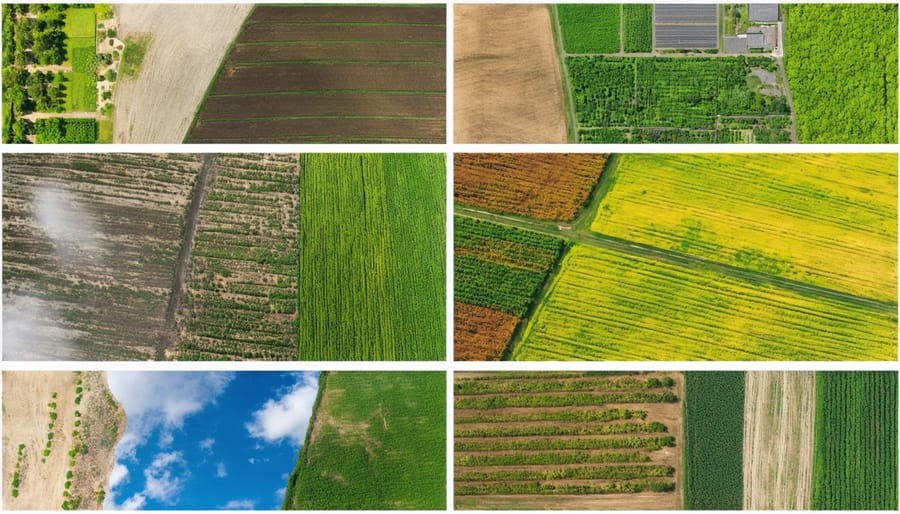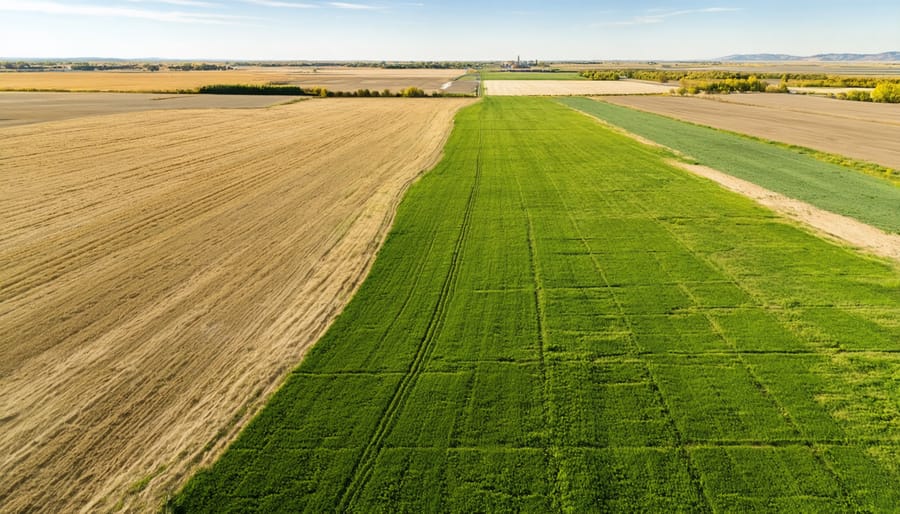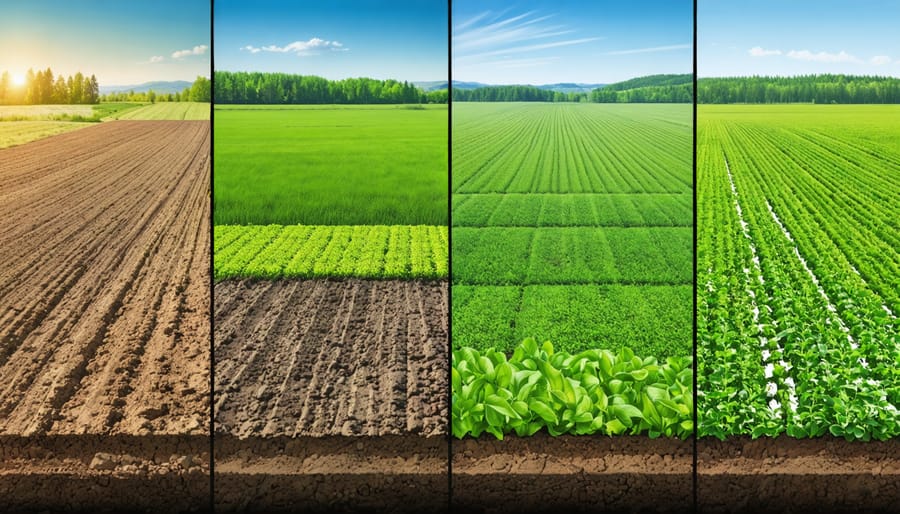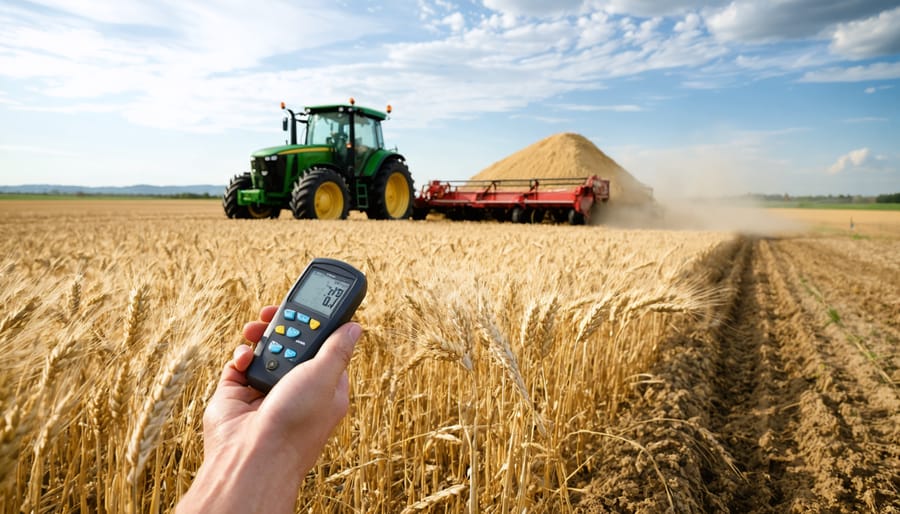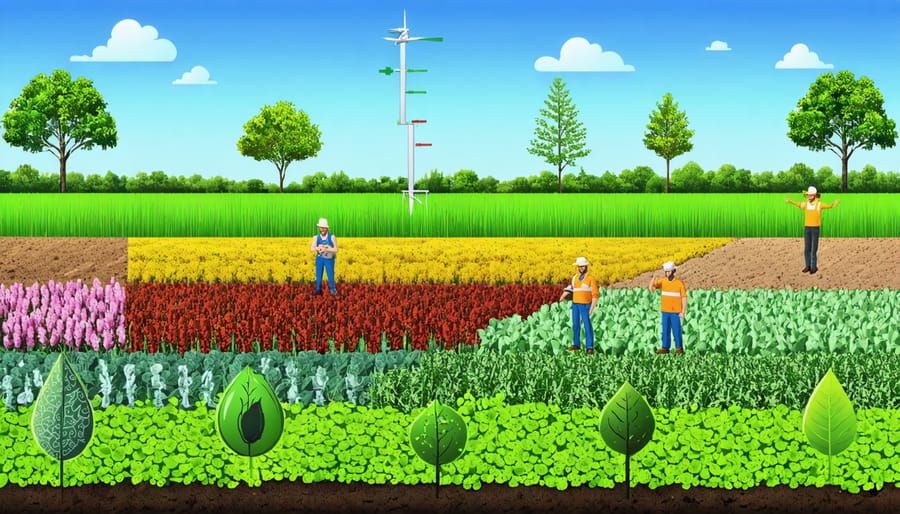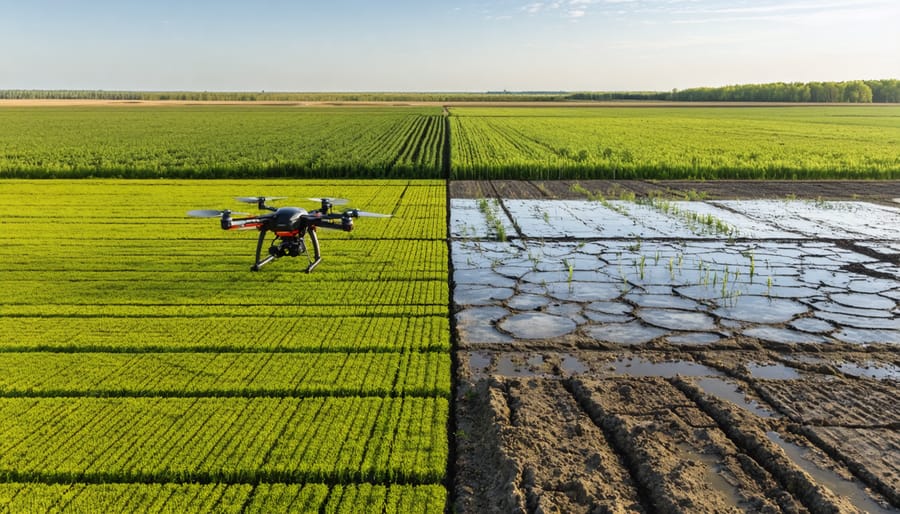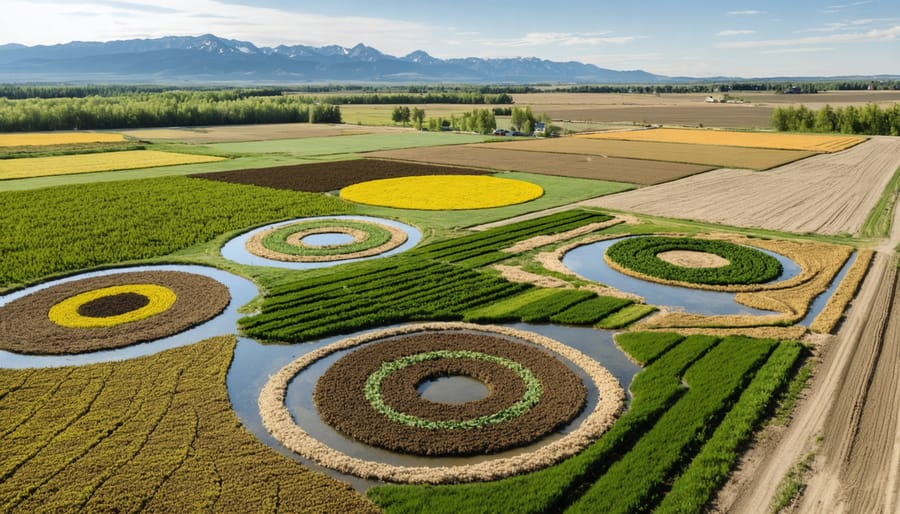Climate Adaptation Science Centers across Alberta are transforming how farmers tackle climate challenges, providing cutting-edge solutions backed by real-world data from Canadian fields. Operating as vital hubs where agricultural science meets practical farming, these centers bring together soil scientists, meteorologists, and local farmers to develop resilient farming strategies tailored to Alberta’s unique growing conditions.
These institutions serve as bridges between research laboratories and farm fields, translating complex climate data into actionable strategies for Canadian producers. Through their work, farmers gain access to seasonal forecasting tools, soil management techniques, and crop variety recommendations specifically designed for changing climate patterns in the Prairie provinces.
The network of centers, strategically positioned throughout Alberta’s agricultural regions, has already helped over 2,000 farmers implement climate-adaptive practices, resulting in measurable improvements in crop yields and soil health. Recent success stories include the development of drought-resistant canola varieties and innovative irrigation systems that have reduced water usage by 30% while maintaining productivity.
For Alberta’s agricultural community, these centers represent more than research facilities – they’re practical resources offering immediate solutions to pressing climate challenges, ensuring our farms remain productive and sustainable for generations to come.
The Alberta Climate Adaptation Network
Key Research Facilities
Alberta’s leading climate adaptation research takes place at several key facilities across the province. The University of Alberta’s Agriculture, Life & Environmental Sciences (ALES) facility in Edmonton houses state-of-the-art laboratories focusing on drought-resistant crop development and soil health monitoring. Their 20-hectare research farm provides real-world testing grounds for climate-adaptive farming techniques.
In Lethbridge, the Agriculture and Agri-Food Canada Research Centre specializes in irrigation management and climate-resilient livestock systems. Their controlled-environment facilities allow researchers to simulate various climate scenarios and develop practical solutions for farmers.
The Olds College Smart Farm, spanning 890 hectares, serves as a living laboratory where researchers test innovative agricultural technologies in real farming conditions. Their data-driven approach helps farmers make informed decisions about climate adaptation strategies.
The Prairie Adaptation Research Collaborative (PARC) in Regina, while not in Alberta, works closely with Alberta institutions to study prairie-specific climate challenges. Their research directly benefits Alberta farmers through regional climate modeling and adaptation planning.
These facilities welcome farmer participation through open houses, workshops, and collaborative research projects, making scientific discoveries accessible to the agricultural community.
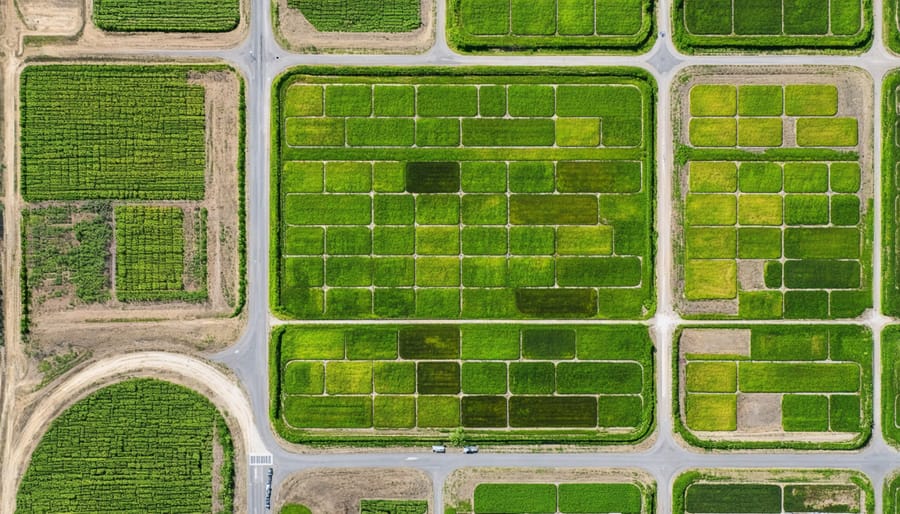
Partner Organizations
Climate Adaptation Science Centers thrive through robust partnerships with key organizations across Alberta and Canada. The University of Alberta and Olds College serve as primary academic partners, providing research facilities and connecting farmers with leading agricultural scientists. These institutions offer specialized programs in sustainable agriculture and climate-adaptive farming techniques.
Government collaboration includes Agriculture and Agri-Food Canada, Alberta Agriculture and Forestry, and local conservation authorities. These partnerships ensure that research findings translate into practical policies and support programs for farmers. The Alberta Federation of Agriculture and various regional farming cooperatives actively participate in field trials and knowledge sharing.
Local farming communities play an essential role through demonstration farms and peer-to-peer learning networks. Notable examples include the Lacombe Research Centre and the Lethbridge Research Station, where farmers can observe climate-adaptive practices firsthand. Indigenous communities contribute valuable traditional knowledge about sustainable land management through partnerships with organizations like the First Nations Agricultural Association of Alberta.
These collaborative relationships create a strong support network that helps farmers access resources, share experiences, and implement climate-adaptive strategies effectively.
Innovative Soil Management Solutions
Drought-Resistant Soil Practices
Research from Alberta’s Climate Adaptation Science Centers has revealed several effective drought-resistant farming practices that focus on soil health maintenance during dry periods. Key findings show that incorporating organic matter through cover cropping and crop residue management can increase soil water retention by up to 25%.
Local studies demonstrate that maintaining soil structure through reduced tillage helps create stable soil aggregates, improving water infiltration and storage. Farmers implementing these practices report maintaining crop yields even during periods of reduced rainfall, with some noting a 30% increase in soil moisture retention compared to conventional methods.
The centers recommend a three-pronged approach to soil management: diversifying crop rotations to include drought-tolerant varieties, maintaining year-round soil coverage, and implementing strategic composting practices. These methods have proven particularly effective in southern Alberta’s semi-arid regions, where annual rainfall can be as low as 300mm.
Recent field trials show that farms using biochar amendments have improved their soil’s water-holding capacity by up to 20%. Additionally, implementing strategic mulching techniques has helped reduce soil moisture evaporation by 40% during peak summer months. These practices not only protect against drought but also contribute to long-term soil health and farm sustainability.
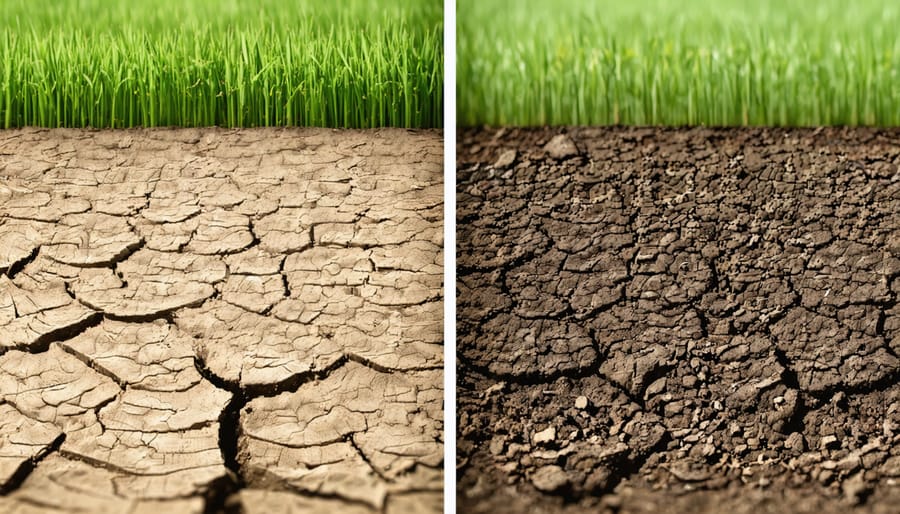
Carbon Sequestration Techniques
Alberta farmers are leading the way in implementing innovative carbon sequestration techniques that enhance soil health while fighting climate change. Recent studies from our climate adaptation centers show that combining cover cropping with minimal tillage can increase soil carbon storage by up to 0.5 tonnes per hectare annually.
Regenerative grazing practices have proven particularly effective in our prairie regions, where carefully managed cattle rotation helps build organic matter in the soil. Local farmers using this method report improved soil structure and water retention, with some achieving a 2% increase in soil organic carbon over five years.
Another promising approach is the integration of perennial crops into traditional annual rotations. Research conducted at Alberta climate adaptation centers demonstrates that deep-rooted plants like alfalfa can store carbon at depths of up to 2 metres, providing long-term storage benefits.
Biochar application is gaining traction among innovative producers, with early adopters reporting significant improvements in soil structure and carbon retention. When combined with composting, biochar can help sequester carbon for hundreds of years while improving soil fertility.
Our centers provide hands-on training and support for implementing these practices, with demonstration plots showing real-world results in various soil types across Alberta. Regular soil testing and monitoring help farmers track their progress and adjust methods for optimal results.
Erosion Prevention Strategies
As Alberta’s climate continues to shift, our Climate Adaptation Science Centers have developed proven erosion prevention strategies tailored to our unique agricultural landscape. These methods combine traditional knowledge with innovative techniques to protect valuable topsoil.
Cover cropping has emerged as a leading practice, with centers recommending cold-hardy varieties like fall rye and winter wheat that thrive in our climate. These crops provide essential soil protection during vulnerable periods between growing seasons, while building organic matter and improving soil structure.
Contour farming and strip cropping have shown remarkable success in reducing soil loss, particularly in rolling terrain common across central Alberta. By working with the natural landscape features, these techniques can reduce erosion by up to 50% compared to conventional methods.
Wind barriers, including shelterbelts and permanent grass strips, are being strategically implemented based on detailed wind pattern analysis. Our centers help farmers determine optimal placement and species selection for maximum protection.
Conservation tillage practices, adapted for our shorter growing season, have been refined to maintain crop residue while managing soil moisture effectively. This approach has helped many Alberta farmers reduce erosion while maintaining productive yields.
The centers also provide soil moisture monitoring systems and erosion risk assessment tools, helping farmers make informed decisions about timing their field operations to minimize soil disturbance during vulnerable periods.
Real-World Implementation
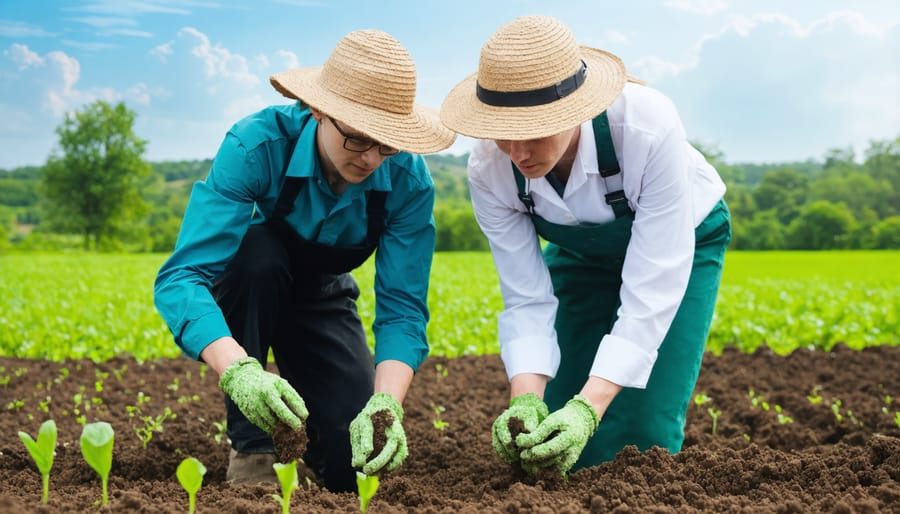
Success Stories from Local Farms
The Smith family farm in Lethbridge County stands as a shining example of successful climate adaptation. After implementing recommendations from their local center, they’ve seen a 30% increase in soil water retention through modified tillage practices and crop rotation strategies. Their success inspired neighboring farms to adopt similar approaches, creating a ripple effect throughout the community.
In Red Deer County, the Jensen’s organic operation transformed their vulnerability to extreme weather events into resilience. Working closely with center specialists, they implemented windbreaks and moisture conservation techniques that helped them maintain steady production despite challenging conditions. Their innovative approach to cover cropping has reduced soil erosion by 40% while improving overall soil health.
The Mountain View Hutterite Colony showcases how traditional farming wisdom can blend with modern climate adaptation strategies. Their partnership with the center led to the development of drought-resistant wheat varieties specifically suited to Alberta’s changing climate. The colony’s grain yields have remained stable even during recent dry seasons, and they’ve reduced irrigation needs by 25%.
Perhaps most inspiring is the story of young farmer Sarah Thompson in Cardston County. Starting with just 160 hectares, she utilized the center’s soil monitoring program to optimize her regenerative grazing practices. Within three years, she documented a significant increase in soil organic matter and reduced her vulnerability to both drought and flooding conditions.
Economic Benefits
Alberta farmers implementing climate-adaptive practices through our science centers have experienced proven economic benefits that directly impact their bottom line. Data collected from participating farms shows an average 15-20% reduction in irrigation costs and a 25% decrease in fertilizer expenses within the first two years of adoption.
These savings are particularly significant in drought-prone regions, where adaptive water management techniques have helped farmers maintain crop yields while using less water. For example, farms in Southern Alberta using moisture monitoring systems and drought-resistant crop varieties have reported yield increases of up to 30% during dry seasons.
The long-term financial advantages are equally impressive. Farms implementing soil health improvements through our recommended practices have seen organic matter content increase by 2-3% over five years, resulting in better water retention and reduced input costs. This translates to an average annual savings of $75-100 per hectare on operational expenses.
Risk management benefits are also substantial. Farms using our climate-adaptive strategies have shown greater resilience to extreme weather events, with crop insurance claims dropping by 40% compared to conventional operations. Additionally, diversification strategies recommended by our centers have helped create new revenue streams, with many farmers reporting 15-25% increases in total farm income through value-added products and climate-smart crop selections.
Getting Involved
Resources and Support
Alberta’s Climate Adaptation Science Centers offer comprehensive support through various programs tailored to local agricultural needs. Our seasonal workshops cover topics from soil health management to water conservation techniques, with hands-on demonstrations at partner farms across the province.
Farmers can access one-on-one consultation services, where our specialists provide personalized guidance for implementing climate-adaptive practices specific to your operation. These consultations include soil testing, climate risk assessments, and customized adaptation strategies.
We maintain a digital resource library featuring practical guides, case studies, and research findings, all accessible through our online portal. Monthly webinars connect you with leading agricultural experts and fellow farmers, fostering knowledge sharing within our community.
Our mobile outreach team regularly visits rural communities, bringing expertise directly to your area. We also offer grant-writing assistance for climate adaptation projects and maintain partnerships with local agricultural associations to ensure comprehensive support.
For emergency climate-related challenges, our rapid response team provides immediate guidance through our 24-hour helpline. Connect with us through your local agricultural extension office or visit our website to access these resources.
Future Initiatives
Several exciting initiatives are on the horizon for Alberta’s climate adaptation centers in 2024-2025. A new soil health monitoring network will launch across the province, allowing farmers to contribute field data and access real-time analytics. This citizen science approach will help build a comprehensive database of soil conditions across different agricultural zones.
The centers are also developing a mobile app that will provide farmers with personalized climate adaptation recommendations based on their specific location and crop types. Training workshops will be offered in various communities, focusing on regenerative agriculture techniques and innovative water management strategies.
Research partnerships with local farms are expanding, with opportunities for producers to participate in field trials of climate-resilient crop varieties. A mentorship program is being established to connect experienced climate-adaptive farmers with those beginning their sustainability journey.
Farmers interested in participating can register through their local center. Priority will be given to operations demonstrating commitment to sustainable practices and willingness to share their learning experiences with the broader agricultural community. Regular updates on these initiatives will be available through quarterly newsletters and community meetings.
Climate Adaptation Science Centers stand as vital pillars supporting Alberta’s agricultural resilience in the face of changing weather patterns. These centers have proven instrumental in helping countless farmers across the province adapt their practices, resulting in more sustainable and profitable operations. Through their combination of research, practical support, and community engagement, they’ve created a robust framework for agricultural innovation that continues to evolve with our changing climate.
The impact of these centers extends far beyond individual farms. By fostering collaboration between researchers, agricultural professionals, and farmers, they’ve created a knowledge-sharing network that strengthens our entire agricultural community. The solutions developed and tested through these centers have helped preserve soil health, improve water management, and increase crop yields across diverse growing conditions throughout Alberta.
Looking ahead, these centers will play an increasingly crucial role in securing our agricultural future. Their work in developing climate-adaptive strategies, combined with their commitment to practical, farmer-focused solutions, positions them as essential resources for the next generation of Canadian farmers. The continuous evolution of their research and support services ensures that Alberta’s agricultural sector remains competitive and sustainable.
For farmers considering engaging with these centers, the benefits are clear: access to cutting-edge research, practical implementation support, and a community of forward-thinking agricultural professionals all working toward a common goal – building a resilient and prosperous agricultural future for Alberta.

